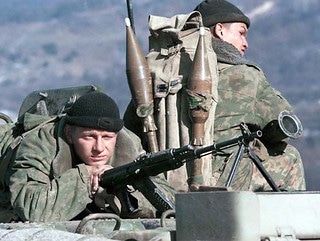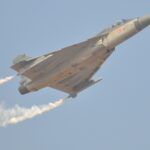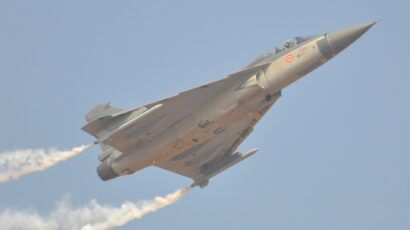Is Russia preparing for war?
By Lauren Sukin | December 9, 2021
 Russian soldiers. Russian Federation. Credit: Jesse. Accessed via Flickr. CC BY-SA 2.0.
Russian soldiers. Russian Federation. Credit: Jesse. Accessed via Flickr. CC BY-SA 2.0.
Approximately 100,000 Russian troops housed in rows upon rows of barracks have amassed near the Russia-Ukraine border. Moscow claims they are there to conduct routine military exercises. And they have. Amidst political crisis in Belarus this fall, for example, up to 200,000 Russian and Belarusian forces participated in the Zapad 2021 exercise series.
Yet many observers worry these exercises are largely a pretense, and the soldiers’ stay may be more permanent. US military intelligence reported Russia may be preparing as many as 175,000 troops for offensive operations into Ukrainian territory.
“We don’t know whether President Putin has made the decision to invade,” Secretary of State Antony Blinken said. “We do know that he is putting in place the capacity to do so on short order.”
Moscow calls claims that it plans to attack its southern neighbor false. After all, military exercises are routine. They allow forces to practice key maneuvers, improve coordination with allied militaries, and build plans to manage persistent and emerging threats. But just because training is routine doesn’t mean it is risk-free.
Military exercises have historically been used to prepare for war and to cover up plans for surprise attacks. Yet rather than deterring aggression, these activities can escalate already-tense environments. In a hotbed like Ukraine, the United States and Russia may want to run from additional exercises.
Expanding operations in Europe. Recently, military exercises have been a hallmark of high tensions in Eastern Europe. As Russia scaled up military resources on its Western border, the United States warned Moscow not to make a “serious mistake.” France cautioned further Russian aggression could have “serious consequences.” Russian President Vladimir Putin retorted that ongoing US-NATO operations in the Black Sea were a “serious challenge” for Russia. Putin also advised NATO against stepping up its defense of Ukraine, adding that any deployment of weapons, missile defenses, or soldiers to Ukraine would cross a “red line” that invites retaliation. Meanwhile, Kyiv wants more helicopters.
This latest back-and-forth continues a long pattern of expanded military exercises in Europe. Between 2013 and 2020, nearly 3,000 of these events placed Russian and NATO forces in close proximity. During the same period, the pace grew by more than 60 percent. The coronavirus pandemic briefly depressed the number—NATO reports just 88 of 113 planned events took place in 2020—but things were back to normal by 2021.
US and NATO exercises in Europe have largely been aimed at deterring Russian aggression, although the forces also regularly practice for other missions, such as counterterrorism, humanitarian aid, and search-and-rescue operations. The United States has exercised with both NATO allies and non-NATO partners, including Ukraine and Georgia. (While the United States backs both states’ rights to sovereignty and has supported both militaries, the alliances lack formal defense pacts.)
Russia has similarly ramped up activity in recent years. Although Russia paused large-scale military exercises after the end of the Cold War, it re-introduced the practice around 2009. This effort has been integral to Putin’s efforts to strengthen the Russian military.
Why states conduct military exercises. Exercises help states work out kinks in their strategy and planning processes, which improves their warfighting abilities. Militaries can test out new technologies, provide operational training, practice complex maneuvers, and assess logistics and resource needs. Joint military exercises also enable states to signal commitment to their allies and partners as well as to improve military interoperability—or military-to-military communication and coordination. These are just some of the many benefits.
States also engage in this practice to demonstrate their military capabilities to their adversaries. Zapad 2021, for example, was “meant to convey the potential costs and escalation risks” of a NATO-Russia conflict. Military operations—especially when they are large, expensive, or complex—communicate resolve. Russian exercises in the Black Sea, for example, have been accompanied by rapid modernization of the Russian naval fleet, expanded territorial claims in waters near Crimea, and repeated warnings to US and NATO forces in the region. In the process, Moscow broadcast its view that the Black Sea is integral to its security.
Some scholars suggest demonstrations of capabilities can deter aggression—or at least not worsen it. But others argue these pursuits can prove dangerous, especially when they “provoke provocative rhetoric and actions.”
The risks of military exercises. When a state builds its military capabilities and signals its commitment to fight, its adversaries perceive stronger threats to their security. Adversaries may, in turn, counter with their own demonstrations of resolve, and the situation can spiral. Such a downward spiral may currently be underway in Eastern Europe, as NATO and Russia trade both barbs and exercises.
In our research, Jordan Bernhardt and I find that exercises may escalate, rather than deter, conflict. Exercises are perceived as legitimate threats, and this perception leads to reciprocal hostility. We find that South Korean joint military exercises between 1997 and 2016 did not deter North Korea. Instead, North Korea responded systematically with both aggressive rhetoric and provocative actions, such as missile and nuclear tests.
Responses to military exercises reflect the risks they pose. For example, exercises that are large, practice traditional combat activities, or that occur on the Korean Peninsula elicit stronger reactions than those that are small, practice non-combat missions, or occur far away. This means not only have exercises failed to effectively deter North Korea, but they have also worsened tensions in this already-difficult environment.
Moreover, North Korea isn’t just furthering a routine agenda of provocation. Rather, North Korea shows reciprocal hostility to actions it sees as legitimate threats to its security. Although our research focuses on Northeast Asia, the fear of exercises driving this escalatory process isn’t unfounded—in this region or in Eastern Europe.
Close calls. Military exercises practice imaginary wars, but some have nearly started real ones. Perhaps most notable is the Able Archer incident. This 1983 nuclear war game, codenamed “Able Archer 83,” allowed US and NATO forces to stage a slow escalation from a conventional to a nuclear war. As these forces practiced moving through the DEFCON (defense readiness condition) phases, the Soviet Union watched warily. Were the reports that US nuclear forces had been placed on alert evidence a nuclear war was imminent? Unsure, Moscow reportedly began to prepare for a surprise nuclear attack. Although some debate remains over the seriousness of the Soviet response to Able Archer, the episode highlights the potential for exercises to lead to dangerous misunderstandings.
These risks continue to threaten Europe’s stability. During a 2020 NATO exercise in the Black Sea, a Russian fighter jet came within 100 feet of a US nuclear-capable B-52 bomber. In June, Russia reported firing “warning shots” and dropping bombs in the path of the British warship HMS Defender as it sailed near Crimea. The UK government brushed off the incident, reporting Russia was simply conducting “gunnery exercises.” In November, Moscow claimed the United States had “rehearsed launching nuclear weapons against Russia” after a series of strategic bomber flights. Russia claimed US bombers came as close as 20 km to Russian airspace.
Russia’s accusations weren’t entirely wrong. The flights were part of Global Thunder, an annual event run by US Strategic Command. Global Thunder involves “realistic training activities against simulated adversaries with the goal…to further improve nuclear readiness and strategic deterrent capabilities.” The United States insisted their activities, conducted in coordination with allies, were announced and followed the relevant international protocols.
Fortunately, each of these close calls have remained just that. Yet it’s easy to see how simple missteps or miscommunications could have caused these incidents to escalate.
Exercises can not only lead to accidental wars, but they can also be precursors to intentional ones. In 1973, Egypt began training near the Suez Canal to mobilize forces before the start of the Yom Kippur War. In 1987, India’s massive Operation Brasstacks created a crisis with Pakistan, which some Indian military officials hoped would escalate to war.
Analysts note Russian exercises have previously been used to surreptitiously move forces and equipment into Eastern European theaters. During the Cold War, NATO planners feared Soviet wargames in Central Europe were bringing in new forces before the troops they claimed to be replacing had left. Moscow used a similar tactic in 1968, when Warsaw Pact exercises in and near Czechoslovakia brought additional forces to the region before a Soviet-led invasion took place.
More recently, Russia has used exercises near its borders as part of an emerging “hybrid warfare” practice. While Moscow funnels support to separatist movements, it also conducts large training operations intended to destabilize the security environment by cautioning Russia’s adversaries against retaliating. Russia used this tactic prior to its 2008 invasion of Georgia and before its 2014 occupation and subsequent annexation of Crimea. Russia’s buildup of forces near Ukraine—under the guise of military exercises—has therefore rightfully raised eyebrows in Washington.
A safer path forward. Exercises pose real dangers of both accidental and intentional escalation. Although they may be intended to build defensive capabilities or to stop further aggression from taking place, their risks should not be understated. In Eastern Europe, this means worries about the intentions behind Russia’s recent activities should be taken seriously—and that further NATO exercises may not be the best response.
Fortunately, the United States appears to be listening to concerns that its exercises have grown too provocative. The United States recently began a systematic review of its exercise activity in Europe. The White House insists no decision has been made to modify or curtail these pursuits. However, Pentagon Press Secretary John Kirby remarked that the assessment “is in keeping with our collective desire to see a de-escalation of tensions in the region and to help create more space for diplomatic resolution.”
States should also make exercises safer. Militaries can, for example, prioritize smaller or non-combat trainings in high-tension arenas. These activities still improve training and coordination—at lower risk. States should also embrace transparency, announcing their plans and providing adversaries with advance details.
The United States and Russia are both party to the Vienna Document, which outlines measures intended to reduce the dangers associated with military exercises. For example, the agreement requires states to share information on any exercises involving more than 13,000 troops—although the Congressional Research Service reports that Russia “routinely avoids these requirements.” The United States should continue to encourage better Russian compliance, as investments in transparency, confidence-building, and other safeguards could make it easier for both states to reap the benefits—without as many risks.
Together, we make the world safer.
The Bulletin elevates expert voices above the noise. But as an independent nonprofit organization, our operations depend on the support of readers like you. Help us continue to deliver quality journalism that holds leaders accountable. Your support of our work at any level is important. In return, we promise our coverage will be understandable, influential, vigilant, solution-oriented, and fair-minded. Together we can make a difference.
Keywords: Europe, Russia, Ukraine, nuclear risk, nuclear weapons, war, warfare, wargame
Topics: Nuclear Risk, Nuclear Weapons
















This otherwise interesting and informative article misses an important factor that could lead to an outbreak of hostilities: A Ukrainian government buildup of forces at the buffer zone with the Donbas region. Feints by Ukraine could trigger a pre-emptive move by Russia, and vice versa. There is almost nothing in the US mainstream media about Ukraine’s significant buildup at the buffer zone, a buildup perhaps encouraged by the US’s supply of “defensive” armaments to Ukraine.
Am surprised the Vienna document/created only got brief notice at the end of this article. These are treaty commitments signatory states, including Russia, have pledged to honor. If OSCE is to have any teeth, holding Russia accountable to the Vienna Document should be the first step.
How would the US respond to Russian military exercises on the Mexico-US border? Placing of missiles on that and the border with Canada? The US went ballistic in the 1960s when the USSR placed missiles in Cuba. And yet the US is placing anti-missile, first strike weapons on the borders of Russia and running the NATO military up to the borders of Russia. The problem with this article is that it seriously downplays the provocations by the USA. It ignores all the wars the US has started over the last decades and the warmongers in and out our government calling… Read more »
An excellent article! You have used historical events (military confrontations that could have escalated) to provide some insight into both where we’ve been, and where we’re probably headed. Military aggression from emboldened authoritarian states pose a significant threat to peace, and the safety and security of those being targeted by them.
Perhaps the fact that I am no longer a naïve teenager with high testosterone and low intellectual activity is what gives me pause with the Russia/Ukraine issue. The Ukraine has been an integral part of the Russian hegemony [difficult to place a permanent marker on exactly what the status is/was of Russian satellite states[?] during the past 300 odd years] for more than 300 years. Longer than any State has been a part of the United states’ hegemony. When the South tried to break away, there ensued a dreadful civil war that ended up in the subduing [and some would… Read more »
The problem is that in Russia the older population who still support Putin are Stalinists that yearn to bring back the Soviet union and its sphere of influence. Putin has to please these masses to keep getting re-elected. The younger population supports Navalny more but before the old geezers die off there’s still time for the power elite to bring back Soviet Union. This is why Russia must be prevented, not provoked from taking Ukraine. It would be very hard if not impossible to retake Ukraine once Russia has it just like is the case with Crimea. Some 200,000 European… Read more »
Some of the arguments would be viable, if, they were made in the context of NATO or the US parking CBM’s in Ukraine. What seems to be lacking here is something that Ari broached and upon which I intend to expand. Felix Dzerzhinsky (Lenin’s Chief of the NKVD) had a statue dedicated to his memory in Lubyanka Square outside KGB headquarters. That statue was removed in 1991. Yes you can read all about it on Wikipedia. What you won’t read about however is that the statue of Felix has made it’s way back to it’s place of prominence in Lubyanka… Read more »
West is blaming Russia for everything – Why, Russian troops are inside Russian territory, what about US troops- everywhere in Europe around Russia and still blaming Russia – there is something wrong with the world.
Yes Russia took Crimea, but then if not- US navy would had a great naval Base-